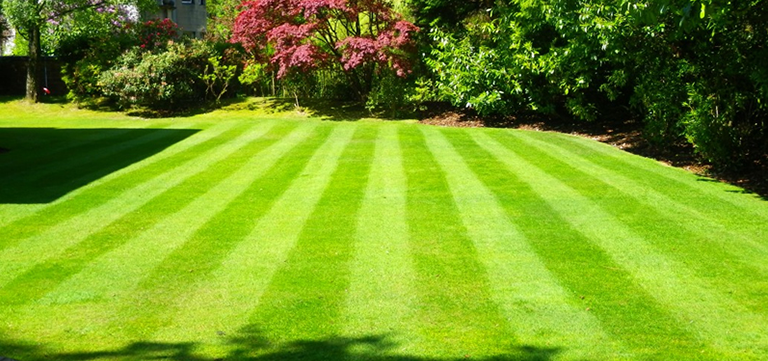Courtesy outsidepride.com
Grasses used in Georgia can be divided in to two groups: warm season grasses and cool season grasses. Perhaps the most important factor in developing and maintaining an attractive and problem-free lawn is to choose a grass that is adapted to your area and has the qualities you desire. Georgia has widely differing geographical areas and local climates. A grass that will do well in the southern part of the state may not survive winter in the mountain area. Conversely, cool-season species are not suited to the hot, humid summer of the Coastal Plain area. First, let’s distinguish between cool-season and warm-season species.
Cool-season grasses:
Tall Fescue (Festuca arundinacea). Perhaps the most popular grass in the mountain and upper piedmont areas of Georgia is tall fescue. This is a perennial bunch-type grass that grows rapidly and requires frequent mowing in the spring and fall. Tall fescue needs more water than the warm-season grasses to stay green during the summer. It is quickly established from seed and grows well in full sun as well as moderate shade. Tall fescue will tolerate a wide range of soil conditions, but like most turfgrasses grows best with a soil pH between 5.5 and 6.5. Lawns planted in tall fescue tend to thin out and become “clumpy” thus requiring reseeding every three or more years.
Kentucky Bluegrass (Poa pratensis). Kentucky bluegrass has a medium leaf texture and a bright, pleasing color. There are many varieties which grow well in and north of the upper piedmont areas of Georgia. Kentucky bluegrass can become semi-dormant during hot weather, and grows best in a fertile soil with a pH of 6 to 7. While it does best in partial shade, it will grow in open sun if adequate moisture is present.
Perennial ryegrass (Lolium perenne). Ryegrass is suited for temporary cool-season turfgrasses throughout Georgia. They can be used as a temporary winter cover on new lawns that have not been permanently established. Ryegrasses are also used for overseeding, that is, to provide a green cover on a warm-season grass during the winter. However, overseeding may damage the warm-season grass unless managed correctly in the spring because the ryegrass competes for moisture, sunlight and nutrients.
Warm-season grasses:
Bermudagrasses (Cynodon Spp). All bermudas thrive in hot weather but perform poorly in shade. Bermudas spread so rapidly by both above-and-below-ground runners that they are difficult to control around flower beds, walks and borders. If fertilized adequately, they require frequent mowing. The bermudagrasses are adapted to the entire state and tolerate a wide soil pH.
Carpetgrass (Axonopus affinis). Carpetgrass is a perennial, coarse-leaved, creeping grass which grows in the central and southern regions of the state. It grows better on low, wet soils than do other grasses. It will grow well in either sun or shade but is less shade tolerant than St. Augustine and centipedegrass which it resembles. Carpetgrass may be planted by seed or sprigs. It is not winter hardy and should not be planted north of middle Georgia.
Carpetgrass is recommended only for lawns on wet, low fertility, acid, (pH 4.5-5.5) sandy soils where ease of establishment and care is more important than quality. Its chief disadvantage is rapid seedhead production.
Centipedegrass (Eremochloa ophiuroides). This is a low, medium textured, slow growing but aggressive grass that can produce a dense, attractive, weed-free turf. It is more shade tolerant than bermudagrass but less shade tolerant than St. Augustine and zoysiagrass. Since centipede produces only surface runners, it is easily controlled around borders of flower beds and walks. It is well adapted as far north as Atlanta and Athens.
Centipede is the ideal grass for the homeowner who wants a fairly attractive lawn that needs little care. Centipede does not require much fertilizer or mowing, and compared to other lawn grasses, is generally resistant to most insects and diseases. It will, however, respond to good management and provide a very attractive turf. Centipede can be established from either seeds or sprigs. Since it is slow growing, it takes longer than bermuda and St. Augustine to completely cover.
Centipede is subject to “decline” problems that can be prevented by proper management. This includes care not to overfertilize, prevention of thatch accumulation, irrigation during drought stress, particularly in the fall, and maintaining a mowing height of 1-1 1/2 inches. Centipede is well adapted to soils of low fertility with a pH of 5.0 to 6.0 but grows best, like most grasses, at a soil pH of 6.0 to 6.5.
Zoysiagrasses (Zoysia Spp). Several species and/or cultivars of zoysiagrasses are available in Georgia. Most are adapted to the entire state and form an excellent turf when properly established and managed. For the best appearance, most zoysias require cutting with a reel mower, periodic dethatching, and more frequent irrigation than other warm season turfgrasses. The zoysias form a dense, attractive turf in full sun and partial shade, but may thin out in dense shade. Most zoysias grow very slowly when compared to other grasses.
The zoysiagrasses are (1) slow to cover completely, thus more costly to establish; (2) less drought-tolerant than bermudagrass; and (3) recommended for lawn use only when the homeowner is willing to provide the required maintenance.
Below is the USDA Zone Map for Georgia so you can determine which zone you reside in. Below that are our picks for your state which will do best in your area. Next on this page are tables which list various grasses and their characteristics so you can compare before you decide on your purchase. Click on the product name (ie. La Prima) for more information about that grass and to make your purchase.

